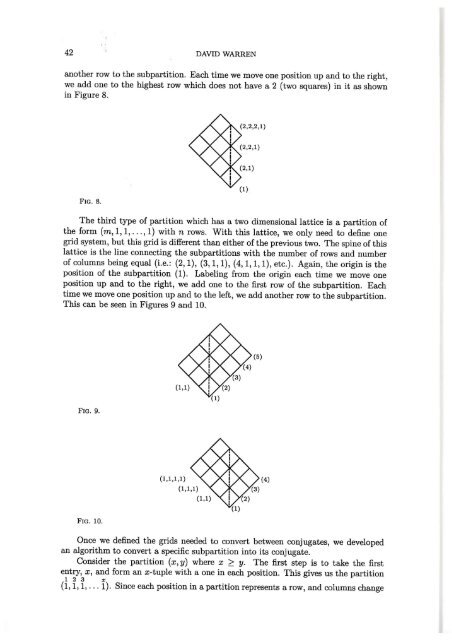You also want an ePaper? Increase the reach of your titles
YUMPU automatically turns print PDFs into web optimized ePapers that Google loves.
42 DAVID WARREN<br />
another row to the subpartition. Each time we move one position up and to the right,<br />
we add one to the highest row which does not have a 2 (two squares) in it as shown<br />
in Figure 8.<br />
FIG. 8.<br />
The third type of partition which has a two dimensional lattice is a partition of<br />
the form (m, 1, 1, ... , 1) with n rows. With this lattice, we only need to define one<br />
grid system, but this grid is different than either of the previous two. The spine of this<br />
lattice is the line connecting the subpartitions with the number of rows and number<br />
of columns being equal (i.e.: (2, 1), (3, 1, 1), (4, 1, 1, 1), etc.). Again, the origin is the<br />
position of the subpartition (1). Labeling from the origin each time we move one<br />
position up and to the right, we add one to the first row of the subpartition. Each<br />
time we move one position up and to the left, we add another row to the subpartition.<br />
This can be seen in Figures 9 and 10.<br />
YOUNG'S LATTICES 43<br />
to rows in the conjugate, we can see that this step gives us the correct number of entries<br />
in the conjugate partition.<br />
The second step is to take the second entry, y, and add one to each of the first y<br />
1 2 3 y-1 Y y+1 X<br />
entries of the x-tuple. This gives us the partition 2, 2, 2,... 2 , 2, 1 , ... 1. This step<br />
takes they elements in the second row of the original partition and changes them into<br />
they elements in the second column of the conjugate. Here again we get the correct<br />
number of entries in the conjugate partition.<br />
<strong>No</strong>te that this pattern holds for every position in ann-tuple partition.<br />
With this algorithm, we can determine the conjugate of any subpartition in a<br />
lattice. Using the appropriate grid, we can then develop the conjugate lattice.<br />
THEOREM 3. The conjugate of a particular lattice is found by reflection about the<br />
spine.<br />
As we were trying to find all the general forms of partitions and their lattices,<br />
we ran into a little problem when we looked at the partition (3, 2, 1) As it turned<br />
out, this is the basic partition with a three dimensional lattice. The lattice for this<br />
partition is shown in Figure <strong>11</strong>.<br />
Working with this partition, we noticed a general pattern that led us to the<br />
following theorem.<br />
(5)<br />
FIG. <strong>11</strong>.<br />
THEOREM 4. Young's lattice for the partition (m, 2, 1, . .. , 1) with n rows is shown<br />
in Figure 12.<br />
FIG. 9.<br />
(1,1,1, ... ,1)<br />
(1)<br />
FIG. 12.<br />
FIG. 10.<br />
Once we defined the grids needed to convert between conjugates, we developed<br />
an algorithm to convert a specific subpartition into its conjugate.<br />
Consider the partition (x, y) where x ~ y. The first step is to take the first<br />
entry, x, and form an x-tuple with a one in each position. This gives us the partition<br />
1 2 3 X<br />
(1, 1, 1, ... 1). Since each position in a partition represents a row, and columns change<br />
Proof. We first show that Young's lattice of the partition (m, 2, 1) is displayed<br />
in Figure 13 by the thicker lines. We proceed by induction on m. By Figure <strong>11</strong>,<br />
this is true for (3, 2, 1). <strong>No</strong>w assume that the lattice for the partition (m, 2, I) is as<br />
shown in Figure 13 by the thicker lines. The only subpartitions of (m + 1, 2, 1) that<br />
are not subpartitions of (m, 2, 1) are (m + 1), (m + 1, 1), (m + 1, 2), (m + 1, 1, 1),<br />
and (m + 1, 2, 1). As pictured by the dashed lines in Figure 13, these subpartitions<br />
connect, as desired, to the lattice for (m, 2, 1).
















